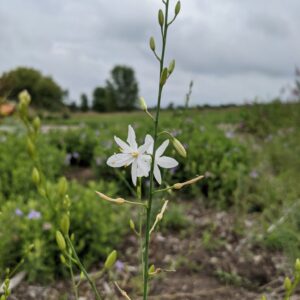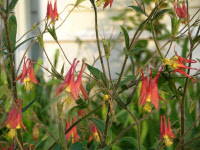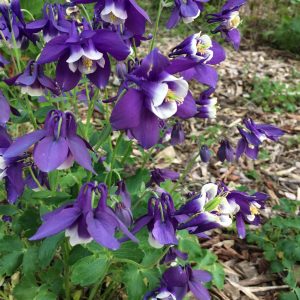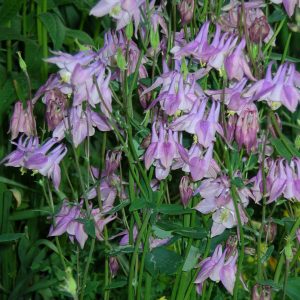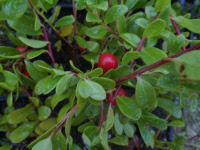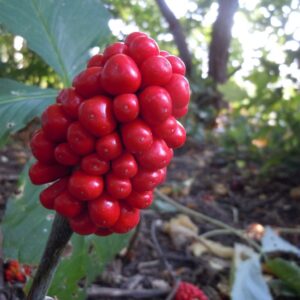Perennials & Biennials
Showing 41–48 of 485 results
-
Anthericum ramosum Spider plant, Branched St Bernard’s-lily Z 5-8
White, branched flower clusters above grass-like leaves June-August
OUT OF STOCK – EMAIL FOR AVAILABILITY
White, branched flower clusters above grass-like leaves June-August
Size: 2-3’ x 12”
Care: full sun in well-drained soil
Native: Western, Central & Southern Europe
Wildlife Value: Attracts bees, butterflies and hummingbirdsPublished by Linneaus in Species Plantarum (1753)
-
Aquilegia canadensis Canada Columbine Z 3-9
In May and June yellow petticoats peek out from under eye-popping red skirts flaring at the ends as these flowers dangle from tall stems.
In May and June yellow petticoats peek out from under eye-popping red skirts flaring at the ends as these flowers dangle from tall stems.
Size: 24-36”x 12”
Care: part shade in moist well-drained soil - moist in spring & dry in summer
Native: Eastern Canada to Florida, west to New Mexico, Wisconsin native.
Wildlife Value: Provides rich, early spring nectar for bumblebees, bees, butterflies, and hummingbirds. Buntings and finches eat seeds. Sole food source for Columbine duskywing caterpillar.
Awards: England’s Royal Horticultural Society Award of Merit.Seeds are fragrant when crushed, used by Omaha, Ponca and Pawnee as perfume. Pawnee used the plant as a love charm by rubbing pulverized seeds in palm of hand and endeavoring to shake hand of desired person. Crushed seeds also used to cure fever and headaches. Cherokee made a tea for heart trouble. The Iroquois used the plant to cure poisoning and to detect people who were bewitched. Grown by Tradescant the Elder in England in 1632. He may have received it from France. Cultivated by Washington & Jefferson. Grown at America’s 1st botanic garden, Elgin Botanic Garden 1811.
-
Aquilegia flabellata v. pumila syn. Aquilegia flabellata ‘Nana’, Aquilegia fauriei Dwarf Fan columbine Z 4-9
April-May lilac blooms of nodding lilac-blue to purple sepals with white petals on compact mound of blue-green foliage
OUT OF STOCK
April-May lilac blooms of nodding lilac-blue to purple sepals with white petals on compact mound of blue-green foliage
Size: 6-9” x 9-12”
Care: sun to part shade in moist well-drained soil, Deadhead for rebloom
Native: Japan
Wildlife Value: deer and rabbit resistant. Attracts butterfliesLatin word flabellatus mean fanlike referring to leaflet shape. First published as Aquilegia buergeriana var. pumila in Swiss journal Bulletin de l’Herbier Boissier 5: 1090. 1897.
-
Aquilegia vulgaris Columbine, Granny’s bonnet Z 3-10
May to June purple, blue, red, pink or white cluster of dangling, bell-shaped petals flaring at the ends, held aloft by upright, arching stems.
May to June purple, blue, red, pink or white cluster of dangling, bell-shaped petals flaring at the ends, held aloft by upright, arching stems
Size: 36”x 18”
Care: Sun or part shade fertile moist well-drained soil
Native: EuropeVery ancient plant. Used medicinally in Middle Ages to cure pestilence, measles, small pox and jaundice and remove obstructions of the liver but large doses are poisonous. Aquilegia was mentioned in the literature of Chaucer and Shakespeare. It was a popular Elizabethan (Elizabeth I in the late 1500’s) cottage garden flower. French botanist Tournefort reported that women used the seeds to “drive out the Measles and Small Pox.” John Winthrop introduced this plant to the New World in the 1630’s. White form by 1600’s. Cultivated in America since 1700’s.
Double form: Aquilegia vulgaris var. plena Grown at America’s 1st botanic garden, Elgin Botanic Garden 1811. Described by L.H. Bailey as of garden origin with “flowers much doubled, ranging from white to deep blue.” (1933)
-
Arcanthemum articum Arctic daisy Z 3- ?
Closely-packed groundcover like a rug of small, classic white daisies with yellow centers.
Closely-packed groundcover like a rug of small, classic white daisies with yellow centers.
Size: 6-18” x spreading
Care: sun to part shade in moist well-drained to well-drained soil
Native: Western Canada to Alaska, North-east Europe to Japan
Wildlife Value: drought tolerantBy 1735
-
Arctostaphylos uva-ursi Bearberry, Bear’s grape, Kinnikinnick Z 2-7
In spring fragrant, pinkish-white bell-shaped flowers, evergreen, glossy foliage and Marlboro red berries in fall.
OUT OF STOCK
“Dwarf ornamental shrub, ornamental in foliage, flowers and berry.” Rand 1866. In spring fragrant, pinkish-white bell-shaped flowers, evergreen, glossy foliage and Marlboro red berries in fall. Great for cascading over edge of wall or groundcover.
Size: 4” x 20” forms dense groundcover over time. Stems root to spread.
Care: sun to part shade in moist well-drained to dry, acidic soil. Needs watering until established. Best grown with protection from wind.
Native: No. America, Wisconsin native
Wildlife Value: Host for several butterfly species including Hoary Elfin, Brown Elfin and Freija Fritillary.
Awards: Cary Award Distinctive Plants for New EnglandKinnikinnick is Algonquin meaning “mixture.” Used as an ingredient in Native American smoke mixtures. For centuries leaves used to make medicinal tea as a tonic and diuretic in many parts of the world. Cheyenne drank the tea to cure back sprains. Some Native Americans used it to cure venereal disease, others to cure pimples and itching, peeling skin. Both Indians and colonists mixed leaves with tobacco for smoking. Collected by Meriwether Lewis on the Expedition.
-
Arisaema dracontium syn. Arum dracontium Green dragon, Dragon root Z 4-9 POISON
A greenish, long-tipped spadix (the "dragon’s tongue") grows several inches beyond a narrow green spathe, a narrow, greenish, hooded, cylinder. Numerous tiny flowers crowd onto the 6-inch-long flower stem. Tiny white flowers in spring turn into a spike of red berries in fall.
OUT OF STOCK
A greenish, long-tipped spadix (the “dragon’s tongue”) grows several inches beyond a narrow green spathe, a narrow, greenish, hooded, cylinder. Numerous tiny flowers crowd onto the 6-inch-long flower stem. Tiny white flowers in spring turn into a spike of red berries in fall.
Size: 1-3’ x 6-8”
Care: part-shade to shade in moist, slightly acidic soil
Native: NH to Florida, west to TX, north to MN. Wisconsin native
Wildlife Value: Deer resistant. Although poison to humans, birds, wild turkeys and wood thrush as well as some mammals eat the berries.Named by 1753. Arisaema, is Greek for “blood arum” or “red arum”. Dracontium, means “of the dragon” in Latin. Named for the resemblance of the spadix to the tongue of a dragon. For the Menominee sacred bundles of the roots and gave the owner the power of supernatural dreams.
-
Arisaema triphyllum Jack-in-the-pulpit, Indian turnip Z 4-9
May-June striped, hooded spathe (leaf-like bract shielding one side of the upright spike), red berries in fall
OUT OF STOCK
May-June striped, hooded spathe (leaf-like bract shielding one side of the upright spike), red berries in fall – a favorite shade plant
Size: 6-24”x 12”
Care: Part shade - shade in moist soil
Native: Eastern No. America, Wisconsin native.Pawnee medicine men pulverized the corm to treat headaches and rheumatism. The Cherokee used it to cure headaches, the common cold, ringworm, boils and “for scald head (and) scrofulous sores.” Iroquois remedied adolescent diarrhea and listless infants with Jack-in-the-pulpit. Also “for nonconception caused by cold blood” and for “temporary sterility.” Chopped root mixed with whiskey cured colds. It induced pregnancy for female horses. Menominee pulverized the root, placed in incised lip to counteract witchery on the face. The seed predicted death or recovery for the Meskwaki who also used it as poison to kill enemies. The Potawatomi discovered that cooking the root for 3 days eliminated the poison. HoChunk spread a compound of the root on neuralgia or rheumatism. Native Americans boiled the berries and roasted the root, for food. Garden cultivation since 1664.
**LISTED AS OUT OF STOCK BECAUSE WE DO NOT SHIP THIS ITEM. IT IS AVAILABLE FOR PURCHASE AT OUR RETAIL LOCATION.

